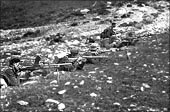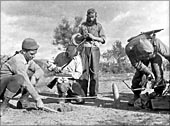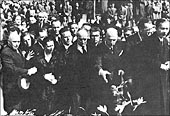|
|
 |
 |
 |
 |
| Resistance activity in the countryside and the cities
In the Greek countryside, ELAS pursued a guerilla war against the Germans and Italians consisting of sabotage and the hindrance of transports, thus assisting the operations of the Allies. From the summer of 1942 onwards, the guerilla groups ΕDES and later ΕKKA were active in the Greek mountains. ELAS and EDES combined their activities in November 1942 in a British plan for the destruction
of the Athens-Thessaloniki railway line, blowing up the Gorgopotamos bridge. The significance of this, one of the most spectacular resistance acts in occupied Europe, was huge, because it hindered the supply of Rommel's German forces from Greece while inspiring enthusiasm and expectation among the people.
Simultaneously with the military action of the guerillas in the countryside, but also prior to it, in Athens and other cities strikes had been organized together with other dynamic mass demonstrations which, thanks to mass support, enthusiasm and the
determimation of the people who participated, had struck severe blows against the occupation authorities. The spontaneous demonstrations by students and strikes linked to economic demands developed into a huge protest movement that was in a constant state of ferment, uniting the resistance voices of workers, civil servants, businessmen and students, and putting pressure on the occupation authorities, foreign and domestic. The strike of 5 March 1943 was legendary, demonstrating the reaction of the Greek people to the recruitment of Greek workers for the Reich, that eventually managed to get the practice suspended while, slightly earlier, the funeral of the poet Kostis Palamas was the pretext for a massive demonstration against the German Occupation that overwhelmed Athens.
|
 |
 |
|








